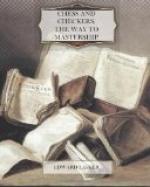Diagram 61 shows a position which occurred in one of the match games played between Emanuel Lasker and S. Tarrasch for the World’s Championship in 1908, and which furnishes a good illustration of the difficulties arising from a backward Pawn. The game proceeded as follows: (1) Ktxd6, Pxd6; (2) Ra1-d1, Q-f6; (3) P-c4, Rf8-e8; (4) Q-g4 (threatening Q-d7) B-c6; (5) R-e2; R-e4; (6) Q-g3, Q-e6 (threatening R-g4); (7) P-h3, R-d8. Black cannot protect the Pawn d6 as many times as White can attack him. It looks as if he could have taken the Pawn c4 with his Queen, but he was probably afraid of the weakness White would have provoked with B-h6, (8) Re2-d2, Re4-e5; (9) B-h6 ! Black cannot take the Bishop on account of Qxe5. (9) ..., Q-g6; (10) B-f4 and wins, as the Pawn d6 as well as the Pawn c5 are doomed.
+---------------------------------------+ 8 | #R | | | #Q | | #R | #K | | |---------------------------------------| 7 | #P | #B | #P | | | #P | #P | #P | |---------------------------------------| 6 | | | | #B | | | | | |---------------------------------------| 5 | | | #P | | | | | | |---------------------------------------| 4 | | | | | ^Kt| | | | |---------------------------------------| 3 | | | | | ^B | | | | |---------------------------------------| 2 | ^P | ^P | ^P | | ^Q | ^P | ^P | ^P | |---------------------------------------| 1 | ^R | | | | ^R | | ^K | | +---------------------------------------+ a b c d e f g h
Diagram 61.
In a position like that of Diagram 45 on White could play P-f4 without making his King’s Pawn backward, as neither a frontal nor a diagonal attack on e3 is possible. Of course, he would have to see that the possibility of such an attack does not arise later on. For instance, he would not be in a position to take the Pawn c5 with the Pawn d4, as this would enable Black to use the diagonal a7-g1 for operations against e3.
The player who endeavors to adhere in all positions to the principles of Chess Strategy outlined in this chapter will rapidly improve his strength and acquire within a short time a much more intimate grasp of the game than others who have had years of practice without making clear to themselves the general laws which govern the outcome of every combination on the Chessboard.
The illustrative games analyzed in the following chapter do not teach anything new. They are merely examples of the application of the general principles to the continuous series of combinations which constitute a game of Chess. The author has chosen games from his own tournament practice as this naturally enabled a more thorough annotation than would have been possible to offer for games of other players.
IV ILLUSTRATIVE GAMES
GAME NO. 1
Played in the Championship Tournament of the Western States, 1917, at Lexington, Ky.




